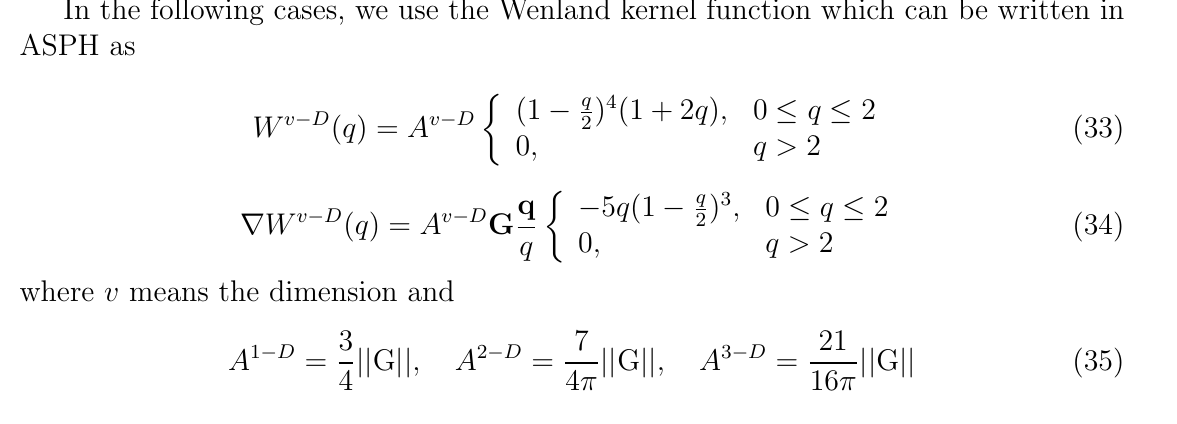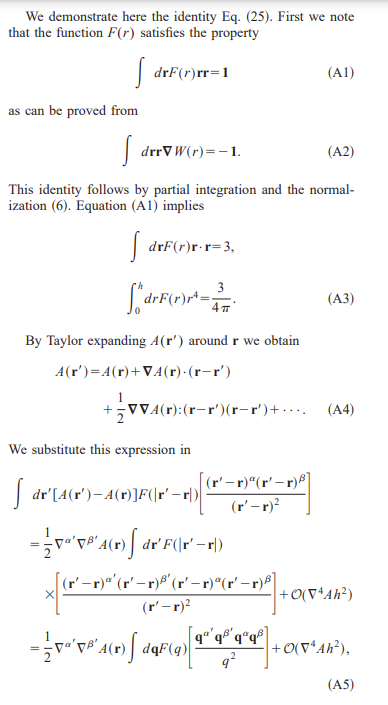What is your conclusion?
Closed Xiaojingtang1234 closed 11 months ago
What is your conclusion?
What is your conclusion?
I do not make or try it out ....confusing..
nonisotropic transform tensor : Vec2d kernel_vector = (1.0, 1.0 / ratio) , ratio can be 2.0, 3.0, 4.0...... transform_angle(1.0) the displacemetnt in formal parameter is posi-posj
Mat2d AnisotropicKernel
::getCoordinateTransformationTensorG(Vec2d kernel_vector, Vec2d transform_angle)
{
Mat2d scaling_tensor = Mat2d(1.0 / (this->h_* kernel_vector[0]), 0.0, 0.0, 1.0 / (this->h_* kernel_vector[1]));
Mat2d rotation_tensor = getTransformationMatrixFromAngle(transform_angle);
Mat2d G_kernel_coordinate = rotation_tensor * scaling_tensor * (~rotation_tensor);
return G_kernel_coordinate;
}this is how i make eij in nonisotropic kernel
Vec2d AnisotropicKernel
::geteij(const Real& distance, const Vec2d& displacement) const
{
Vec2d transformed_displacement_ = this->h_ * transformed_tensor_2d_ * displacement;
return transformed_tensor_2d_ * transformed_displacement_ / (( transformed_displacement_).norm() + TinyReal);
}this is how we get dw of nonisotropic ,
Real AnisotropicKernel
::dW(const Real& r_ij, const Vec2d& displacement) const
{
Vec2d transformed_displacement = transformed_tensor_2d_ * displacement;
Real q = transformed_displacement.norm();
return this->factor_dW_2D_ * this->dW_2D(q);
}factor_dW2D= this->h * this->h det(transformed_tensor2d) this->FactorW2D(); FactorW2D() : factor_W2D = invh invh 7.0 / (4.0 * Pi);
correspond to this formulation
Google test ; this is when Laplacian equals to 2, saturation = xx, while when saturation = yy, Laplacian around 0.01
TEST(test_anisotropic_kernel, test_rij)
{
int y_num = 8;
Real PH = 1.0;
Real ratio_ = 4.0;
Real PL = ratio_* PH;
Vec2d scaling_vector = Vec2d(1.0, 1.0 / ratio_);
Real resolution_ref = PH / Real(y_num);
Real resolution_ref_large = ratio_ * resolution_ref;
int x_num = PL / resolution_ref_large;
AnisotropicKernel<KernelWendlandC2> wendland(1.15 * resolution_ref_large, scaling_vector, Vec2d(0.0));
Real second_order_rate = 0.0;
Real sum = 0.0;
Vec2d first_order_rate =Vec2d(0.0) ;
Vec2d center = Vec2d(resolution_ref_large * 4.0, resolution_ref *4.0);
Real V_ = resolution_ref * resolution_ref_large;
for (int i = 0; i < (x_num + 1); i++)
{
for (int j = 0; j < (y_num + 1); j++)
{
Real x = i * resolution_ref_large;
Real y = j * resolution_ref;
Vec2d displacement = center - Vec2d(x, y) ;
Real distance_ = displacement.norm();
Real sarutration_ = 1.0 * x * x;
Real sarutration_center = 1.0 * center[0] * center[0];
if (wendland.checkIfWithinCutOffRadius(displacement))
{
Vec2d eij_dwij_V = wendland.geteij(distance_, displacement)* wendland.dW(distance_, displacement) * V_;
sum += wendland.W(distance_, displacement)* V_;
first_order_rate -= (sarutration_center - sarutration_)* eij_dwij_V;
second_order_rate += 2.0 * (sarutration_center - sarutration_) * dot(displacement, wendland.geteij(distance_, displacement) )
/ (wendland.getrij(distance_, displacement) + TinyReal)
* wendland.dW(distance_, displacement) * V_ * 1.0 / (wendland.getrij(distance_, displacement)+ TinyReal);
}
}
}
EXPECT_FLOAT_EQ(1.0, sum);
EXPECT_EQ(2.0, second_order_rate);}
*I checked Paul W. Cleary∗ and Joseph J. Monaghan† paper, and use equation 16 with q = transformed_displacement = transformed_tensor2d displacement; it does not work right**. I did not find any other direct materials that have concluded this Laplacian in nonisotropic kernel
https://sci-hub.hkvisa.net/10.1006/jcph.1998.6118
We may try to derive by find the relation factor between isotropic and anisotropic laplacian in its analytical form first. Then apply this relation to the numerical formulation.
We may try to derive by find the relation factor between isotropic and anisotropic laplacian in its analytical form first. Then apply this relation to the numerical formulation.
Could you make a branch with only the anisotropic kernel and the Google test?
sure, i am making
Here is my derivation of the ASPH kernel approximations.
ok i will see , and i already pushed the documents and google test on the branch xiaojing-anisotropic
in my library. (https://github.com/Xiaojingtang1234/SPHinXsys-xiaojing/tree/xiaojing-anisotropic/tests/user_examples)
I use another namespace to seperate the orginal kernel and my kernel.
Some funtions are virtual and checkIfWithinCutOffRadius(Vec2d displacement) ; should be written into base_kernel.h
Please have a check on the new formulation and we can discuss it.
I checked, it seems not right.
I update this part code in my branch according to my understanding.
if i understand correctly, 2|G|G:G is a scalar and the latter actually is the same with previous Laplacian discrization. it cannot modify the nonisotrpic nature in x and y direction.
You can check if the derivation is wrong somewhere.
could you update the new formulation? it seems not right in code. i did not find anything wrong. need to check the theory formulation again
.
Yes. There is Something wrong.
There is the new formulation, it seems correct now.
It seems something wrong . We still consider point (0,0) and (4, 1) for nonisotropic, Phi(r) = x^2+y^2, then we have phiij = Phi(0,0) - Phi_(4,1) = 0- (4x4 -1x1) =-17. but in isotropic case, it is phiij = Phi(0,0) - Phi_(1,1) = 0- (1x1 -1x1) =-2. Weired number 17 cannot be modified by G^2 : phi_ij Tensor;
We do not need modify 17 to 2 for computing the laplacian.
Update the newest formulation. We can have a try.
I am more confused....i will try to have a try.. also i am checking how Laplacian operator works in polar coordinates, trying to find how different coordinates transform. Maybe we can get some useful information from polar coordinates
Where is your confusing ?
The result is bad. The profile is T =x^2
I checked my code implementation, when it is isotropic, it works right. i checked the tensor, it is right, dW is right. I put the code in the branch xiaojing_anisotropic kernel in SPHinxsys resposity, including the kernel. cpp and the google test.
Note we refer this paper, this is the reason why there is a h in G .
https://iopscience.iop.org/article/10.1086/313100/pdf
ok, i checke the code,
at line 42 in google test , we should use Vecd pos_i = Vecd(resolution_x * x_num / 2.0, resolution_y * y_num /2.0 ); // Particle i location
to keep i is always at the center.
Also i am wondering if we could first caculate the gradient T and then caculate the gradient gradient T. Hourglass may exist but it may work.
OK. i checked, result is ugly. the profile is not smooth at all. This does not work
it is ok. We just use this formula and check the diffusion convergence.
non converged in both x and y direction the reference of kernel , paper "ADAPTIVE SMOOTHED PARTICLE HYDRODYNAMICS : METHODOLOGY. II. J. MICHAEL OWEN1 LLNL, " the tensor formation of 2d:
the tensor formation of 2d:
 for B-cubline kernel
for B-cubline kernel

for Wenland kernel: (my conclusion)
refer of SPH dissipative dynamics, https://sci-hub.hkvisa.net/10.1103/PhysRevE.67.026705

 @Xiangyu-Hu
@Xiangyu-Hu